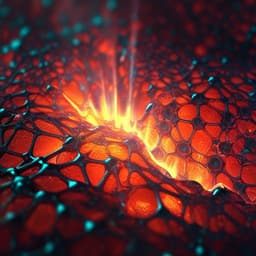
Physics
Nonlinearity-induced topological phase transition characterized by the nonlinear Chern number
K. Sone, M. Ezawa, et al.
This groundbreaking research by Kazuki Sone, Motohiko Ezawa, Yuto Ashida, Nobuyuki Yoshioka, and Takahiro Sagawa reveals a nonlinear Chern number to characterize topological phases in nonlinear systems, uncovering a fascinating bulk-boundary correspondence even in intense nonlinear conditions. Discover how this work opens pathways to explore nonlinear topological materials that were previously disconnected from the linear regime.
~3 min • Beginner • English
Introduction
The study addresses whether and how topological invariants and bulk–boundary correspondence can be extended to nonlinear dynamical systems. While topology in linear systems (for example, the quantum Hall effect) is characterized by invariants like the Chern number that predict robust, gapless boundary modes, nonlinear dynamics are ubiquitous in classical and interacting bosonic platforms. Prior work has observed nonlinear effects on edge modes and soliton-related phenomena, but a clear, generalizable nonlinear counterpart of a topological invariant and its correspondence to boundary states—especially in two-dimensional systems—remained unresolved. This paper proposes a nonlinear Chern number defined from a nonlinear eigenvalue problem with U(1) and translation symmetries, demonstrates its amplitude dependence, and establishes a bulk–boundary correspondence that holds beyond the weakly nonlinear regime. The central hypothesis is that topology in nonlinear systems can be captured by an amplitude-dependent nonlinear Chern number that predicts the emergence or disappearance of edge modes as the oscillation amplitude varies, enabling genuinely nonlinear topological phases disconnected from linear limits.
Literature Review
The paper situates itself in the context of: (1) foundational topological phases in condensed matter (quantum Hall effect; Chern number; bulk–boundary correspondence) with broad extensions to photonics, circuits, ultracold atoms, acoustics, fluids, and mechanical lattices; (2) widespread nonlinearity in classical systems and in mean-field descriptions of interacting bosons (e.g., Gross–Pitaevskii equations), with studies of nonlinear effects on topological edge modes and interplays with solitons and synchronization; (3) reports of nonlinearity-induced topological phase transitions in one-dimensional systems where edge modes depend on amplitude, and efforts to define invariants in strongly nonlinear settings. However, a general, practical topological invariant for two-dimensional nonlinear systems and a corresponding bulk–boundary correspondence remained lacking. This work builds on Bloch-ansatz approaches to nonlinear eigenvalue problems and recent theoretical formalisms to define band-like structures in nonlinear settings, extending them to a concrete invariant (nonlinear Chern number) and its correspondence in 2D.
Methodology
- Nonlinear eigenvalue framework: Consider general conservative, U(1)-symmetric, translation-invariant nonlinear dynamics i ∂t Ψ(r) = f(Ψ; r), where Ψ carries internal degrees of freedom per unit cell. Define nonlinear eigenvectors and eigenvalues by f(Ψ; r) = E Ψ(r). Real E correspond to steady oscillatory states e^{-iEt} Ψ(r).
- Symmetry constraints: U(1) symmetry f(e^{iθ}Ψ; r) = e^{iθ} f(Ψ; r); translation symmetry in lattice and continuum with periodic potentials. Focus on conservative dynamics preserving the total squared amplitude.
- Bloch ansatz and nonlinear band-like description: For lattice systems, use Ψ(r) = e^{ik·r} u(k). In nonlinear systems the Bloch ansatz need not span all solutions (e.g., bulk-localized modes can occur), but the study focuses on bulk-like periodic solutions captured by the ansatz to define a band-like problem f_i(k, φ(k)) = E(k) φ_i(k).
- Fixed-amplitude branch and definition of the nonlinear Chern number: Select special Bloch-ansatz solutions at each k with fixed total squared amplitude w = Σ_i |φ_i(k)|^2 independent of k. Define the nonlinear Chern number C_NL(w) via the Berry connection constructed from these normalized eigenvectors; it reduces to the linear Chern number when f is linear. The invariant is integer-quantized by embedding the nonlinear eigenvectors in a linear Bloch eigenspace.
- Minimal model: Nonlinear Qi–Wu–Zhang (QWZ) model with staggered Kerr-like nonlinearity. In k-space: a two-band model with effective mass term u + κ w. For fixed w, the nonlinear eigenproblem reduces to a linear one, enabling exact analytic bulk eigenvalues/eigenvectors and closed-form C_NL(w). Phase diagram is parameterized by u and κ w.
- Numerical simulations: Real-space time evolution using fourth-order Runge–Kutta on finite lattices with open boundary in x and periodic in y, seeded with edge-localized initial states to detect persistence or spreading. Nonlinear band structures computed self-consistently by iteratively diagonalizing the state-dependent Hamiltonian H(Ψ) at fixed average amplitude and matching eigenpairs across iterations until convergence.
- Continuum effective theory: Derive a nonlinear Dirac Hamiltonian as the low-energy continuum limit near gap-closing points at critical amplitudes. Analyze semi-infinite geometries with open boundary at x=0 to obtain analytic edge-mode profiles and phase boundaries, relating bulk amplitude w to edge amplitudes in open systems.
- Bulk–boundary correspondence proofs: Provide a theorem for weakly nonlinear regimes (nonlinearity small vs. linear bandgap) under assumptions (Hermiticity, U(1), Lipschitz-type bounds) showing C_NL ≠ 0 iff gapless boundary modes exist. Extend analytically to stronger nonlinearity in the continuum Dirac theory, and confirm numerically in lattice models.
- Quench protocol: Propose an experimental protocol exciting edge sites to a prescribed initial amplitude and observing long-time localization as a phase indicator; map observed phase boundaries versus parameters to C_NL(w) predictions by relating bulk and edge amplitudes.
Key Findings
- Definition and quantization of a nonlinear Chern number C_NL(w) for 2D nonlinear systems based on solutions of a nonlinear eigenvalue problem at fixed bulk amplitude w, reducing to the linear Chern number in the linear limit.
- Weakly nonlinear bulk–boundary correspondence: Theorem proves that for conservative, U(1)-symmetric, translation-invariant 2D lattice systems with sufficiently small nonlinearity relative to the linear bandgap, C_NL ≠ 0 if and only if robust gapless boundary modes exist.
- Nonlinearity-induced topological phase transitions: As w varies, band gaps in the nonlinear band-like problem can close and reopen, changing C_NL and the presence of edge modes, even when the linear Chern number would predict triviality.
- Exact analytics in the nonlinear QWZ model: For fixed w, the model is analytically solvable. The nonlinear Chern number is:
C_NL = 1 for −2 < u + κ w < 0; C_NL = −1 for 0 < u + κ w < 2; C_NL = 0 otherwise. This yields explicit, amplitude-dependent phase boundaries and demonstrates nonlinearity-induced transitions without approximation.
- Numerical confirmations:
• Weakly nonlinear regime (e.g., u=−1, κ=0.1, w=0.1): persistent edge-localized states and gapless edge bands consistent with C_NL=±1.
• Trivial regime (e.g., u=3, κ=0.1, w=0.1): absence of edge localization and gapless modes consistent with C_NL=0.
• Nonlinear band structures computed self-consistently show edge modes in topological cases and their absence in trivial cases.
- Continuum nonlinear Dirac Hamiltonian: Low-energy effective Hamiltonian with state-dependent mass m + κ(|Ψ|^2). Analytic edge-mode profiles in semi-infinite geometry reveal phase boundaries that depend on amplitude; cases include conventional localized edge states (m<0), amplitude-independent topological localization (m<0, κ<0), and nonlinearity-induced edge states appearing only above a critical amplitude (m>0, κ<0). Anti-localized profiles also appear uniquely due to nonlinearity.
- Bulk–boundary match in stronger nonlinearity: By relating bulk amplitude w to edge or average amplitudes in open systems, the phase boundaries from the continuum theory coincide with the C_NL(w) transitions.
- Quench dynamics protocol: Simulations mapping long-time edge localization vs. parameters (u, κ w) reproduce phase boundaries consistent with C_NL(w), indicating experimental observability in, e.g., Kerr-nonlinear photonic platforms.
Discussion
The work addresses the open problem of defining a meaningful topological invariant for nonlinear 2D systems and relating it to boundary phenomena. By formulating a nonlinear eigenvalue problem and a fixed-amplitude Bloch-ansatz approach, the authors define an integer-quantized nonlinear Chern number C_NL(w) that depends on the oscillation amplitude. They prove a bulk–boundary correspondence in the weakly nonlinear regime and show analytically and numerically that varying amplitude can induce topological phase transitions absent in linear systems. The nonlinear QWZ model provides exact solvable bulk states and a clear phase diagram, while the nonlinear Dirac Hamiltonian extends insights to continuum systems and stronger nonlinearities, yielding analytic localized and anti-localized edge states and amplitude-dependent phase boundaries. These results establish that genuinely nonlinear topological phases exist, adiabatically disconnected from any linear limit, and that C_NL(w) predicts edge physics observable through band calculations and quench dynamics. The findings are significant for expanding topological materials concepts to nonlinear platforms, guiding experimental realizations in photonics, ultracold atoms, and circuits where Kerr-type nonlinearities are common, and for initiating systematic classification schemes for nonlinear topological phases.
Conclusion
The paper introduces an amplitude-dependent nonlinear Chern number for 2D nonlinear systems, proves its bulk–boundary correspondence in weak nonlinearity, and demonstrates nonlinearity-induced topological phase transitions through exact analytics in a nonlinear QWZ model, continuum nonlinear Dirac theory, and numerical simulations. It establishes the existence of genuinely nonlinear topological phases not connected to linear limits and proposes a practical quench protocol to detect nonlinear edge modes experimentally. Future directions include: comprehensive classification in strongly nonlinear regimes beyond Bloch-ansatz applicability; understanding bulk-localized modes and topological edge solitons within a generalized invariant framework; analyzing stability and modulational instability and their relation to topological transitions; and connecting the nonlinear invariant picture to interacting many-body systems via mean-field or Kohn–Sham mappings.
Limitations
- The Bloch-ansatz framework, central to defining C_NL, may not capture bulk-localized modes and strong-nonlinearity phenomena (e.g., discrete breathers, solitons), limiting applicability in regimes where nonlinearity dominates linear couplings.
- The rigorous bulk–boundary theorem assumes U(1) symmetry, Hermiticity (conservative dynamics), translation invariance, and nonlinearity sufficiently small relative to the bandgap; deviations may invalidate the correspondence.
- Mapping between bulk amplitude w (periodic systems) and edge/average amplitudes under open boundaries is non-unique; different choices (edge vs. average) can be required depending on context and may complicate experimental interpretation.
- Self-consistent band-structure calculations can become unstable in strongly nonlinear regimes; additional numerical methods are needed there.
- Certain localized modes in the continuum theory exhibit non-vanishing asymptotic amplitudes, complicating normalization and finite-size extrapolations.
- Higher-order multifrequency corrections are argued to be excluded under U(1), but more complex nonlinearities could introduce additional effects not captured by the present invariant.
Related Publications
Explore these studies to deepen your understanding of the subject.







